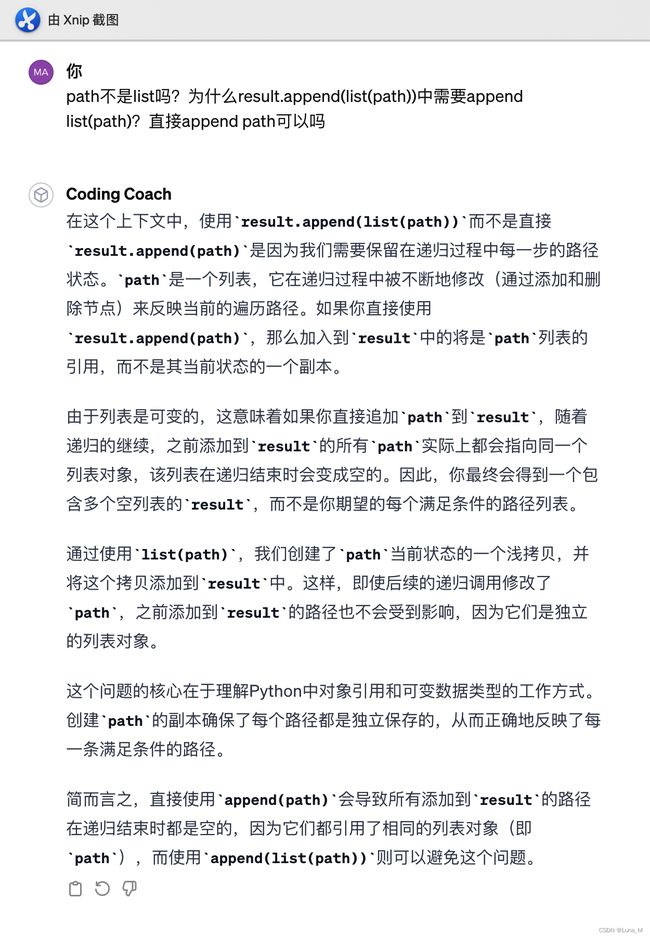python coding with ChatGPT 打卡第17天| 二叉树:找树左下角的值、路径总和
相关推荐
python coding with ChatGPT 打卡第12天| 二叉树:理论基础
python coding with ChatGPT 打卡第13天| 二叉树的深度优先遍历
python coding with ChatGPT 打卡第14天| 二叉树的广度优先遍历
python coding with ChatGPT 打卡第15天| 二叉树:翻转二叉树、对称二叉树
python coding with ChatGPT 打卡第16天| 二叉树:完全二叉树、平衡二叉树、二叉树的所有路径、左叶子之和
文章目录
- 找树左下角的值
-
- Key Points
- 相关题目
- 视频讲解
- 重点分析
- 路径总和
-
- Key Points
- 相关题目
- 视频讲解
- 重点分析
找树左下角的值
Key Points
找出树的最后一行的最左边的值
相关题目
513. 找树左下角的值
视频讲解
递归中带着回溯
重点分析
方法一:层序遍历
def findBottomLeftValue(root):
queue_record = [root]
res = root.val
while queue_record:
level_size = len(queue_record)
for i in range(level_size):
node = queue_record.pop(0)
if i==0:
res = node.val
if node.left:
queue_record.append(node.left)
if node.right:
queue_record.append(node.right)
return res
方法二:层序遍历简洁版
class Solution(object):
def findBottomLeftValue(self, root):
if not root:
return None
queue = [root]
while queue:
current = queue.pop(0)
# 先右后左加入队列,确保左边的节点最后被处理,从而保留在current中
if current.right:
queue.append(current.right)
if current.left:
queue.append(current.left)
# 循环结束时,current中存储的是最后一层最左边的节点
return current.val
这段代码使用了BFS来确保按层遍历树的节点,并且通过在每层遍历时记录遍历到的第一个节点值,最终找到了最后一行最左边的值。请注意,这里故意先将右子节点加入队列,然后加入左子节点,是为了在处理每一层的节点时,最后处理左子节点,但是对于寻找最后一行最左边的值的目的而言,只需要记录每一层第一次访问的节点即可,因此实际上你可以按照正常的顺序(先左后右)加入队列,然后最后处理的节点即为所求。这样的处理方式更直观且易于理解。
方法三:递归法
class Solution:
def findBottomLeftValue(self, root: TreeNode) -> int:
self.max_depth = float('-inf')
self.result = None
self.traversal(root, 0)
return self.result
def traversal(self, node, depth):
if not node.left and not node.right:
if depth > self.max_depth:
self.max_depth = depth
self.result = node.val
return
if node.left:
self.traversal(node.left, depth+1)
if node.right:
self.traversal(node.right, depth+1)
路径总和
Key Points
叶子节点是指没有子节点的节点。
相关题目
112. 路径总和
113. 路径总和ii
视频讲解
路径总和
重点分析
112
方法一:递归
def hasPathSum(root: TreeNode, targetSum: int) -> bool:
if not root:
return False
# 更新目标和
targetSum -= root.val
# 如果是叶子节点,检查目标和是否为0
if not root.left and not root.right:
return targetSum == 0
# 递归遍历左右子节点
return hasPathSum(root.left, targetSum) or hasPathSum(root.right, targetSum)
def hasPathSum(root, targetSum):
if not root:
return False
stack_record = [(root, root.val)]
while stack_record:
node, value = stack_record.pop()
if not node.left and not node.right:
if value == targetSum:
return True
else:
if node.right:
stack_record.append((node.right, value+node.right.val))
if node.left:
stack_record.append((node.left, value + node.left.val))
return False
class Solution:
def pathSum(self, root: TreeNode, targetSum: int) -> [[int]]:
result = []
self.dfs(root, targetSum, [], result)
return result
def dfs(self, node, targetSum, path, result):
if not node:
return
# 添加当前节点到路径
path.append(node.val)
# 检查是否是叶子节点且路径总和等于目标和
if not node.left and not node.right and sum(path) == targetSum:
result.append(list(path))
else:
# 递归遍历左右子节点
self.dfs(node.left, targetSum, path, result)
self.dfs(node.right, targetSum, path, result)
# 回溯前去除当前节点
path.pop()
# 示例使用
# 假设有一个二叉树和目标和,可以创建TreeNode实例并调用Solution().pathSum(root, targetSum)来获取结果
方法二:迭代法
def pathSum(root, targetSum):
if not root:
return []
stack_record = [(root, [root.val])]
res = []
while stack_record:
node, value_list = stack_record.pop()
if not node.left and not node.right:
if sum(value_list) == targetSum:
res.append(value_list)
else:
if node.right:
stack_record.append((node.right, value_list+[node.right.val]))
if node.left:
stack_record.append((node.left, value_list + [node.left.val]))
return res



